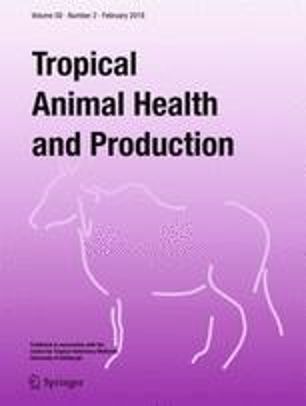Ver ítem
- xmlui.general.dspace_homeCentros e Institutos de InvestigaciónCIAP. Centro de Investigaciones AgropecuariasInstituto de Investigación Animal del Chaco SemiáridoArtículos científicosxmlui.ArtifactBrowser.ItemViewer.trail
- Inicio
- Centros e Institutos de Investigación
- CIAP. Centro de Investigaciones Agropecuarias
- Instituto de Investigación Animal del Chaco Semiárido
- Artículos científicos
- Ver ítem
Spontaneous photosensitization by Heterophyllaea pustulata Hook. f. (Rubiaceae), in sheep from Northwestern Argentina
Resumen
Heterophyllaea pustulata Hook. f. (Rubiaceae) is a phototoxic plant. It grows in the Andean area of northwest of Argentina, and it causes significant economic losses in the livestock. This plant induces dermal lesions by photosensitization probably due to its content of photosensitizing anthraquinones. This paper describes an outbreak of poisoning in Corriedale sheepfold, which had an incidence of 49%. Ear skin biopsies and blood samples were collected of
[ver mas...]
Heterophyllaea pustulata Hook. f. (Rubiaceae) is a phototoxic plant. It grows in the Andean area of northwest of Argentina, and it causes significant economic losses in the livestock. This plant induces dermal lesions by photosensitization probably due to its content of photosensitizing anthraquinones. This paper describes an outbreak of poisoning in Corriedale sheepfold, which had an incidence of 49%. Ear skin biopsies and blood samples were collected of six affected animals. Liver enzymes remained within the reference limits. Histopathologically, a deep necrotizing dermatitis was identified in all samples. H. pustulata was identified in the areas of grazing. Anthraquinone concentration in leaves was 0.84% p/p, expressed as rubiadin. All findings allow us to conclude that the diagnosis is a primary photosensitization. Huge regional economic losses could be attributed to H. pustulata poisoning, although its toxicity has been little studied.
[Cerrar]

Autor
Micheloud, Juan Francisco;
Colque Caro, Luis Adrian;
Comini, Laura Raquel;
Cabrera, Jose Luis;
Núñez Montoya, Susana Carolina;
Martinez, Olga Gladys;
Gimeno, Eduardo Juan;
Fuente
Tropical animal health and production 49 (7) : 1553–1556. (October 2017)
Fecha
2017-10
ISSN
0049-4747
1573-7438 (Online)
1573-7438 (Online)
Formato
pdf
Tipo de documento
artículo
Palabras Claves
Derechos de acceso
Restringido
 Excepto donde se diga explicitamente, este item se publica bajo la siguiente descripción: Creative Commons Attribution-NonCommercial-ShareAlike 2.5 Unported (CC BY-NC-SA 2.5)
Excepto donde se diga explicitamente, este item se publica bajo la siguiente descripción: Creative Commons Attribution-NonCommercial-ShareAlike 2.5 Unported (CC BY-NC-SA 2.5)

